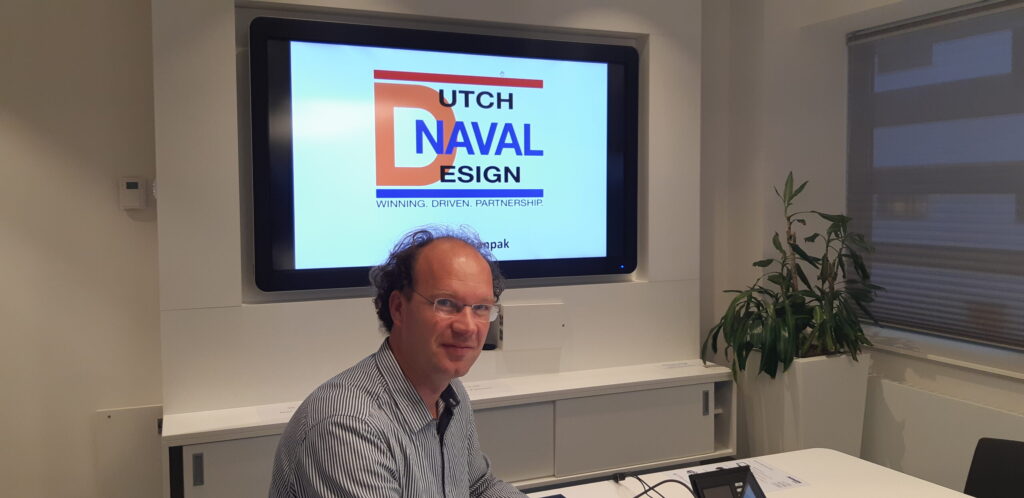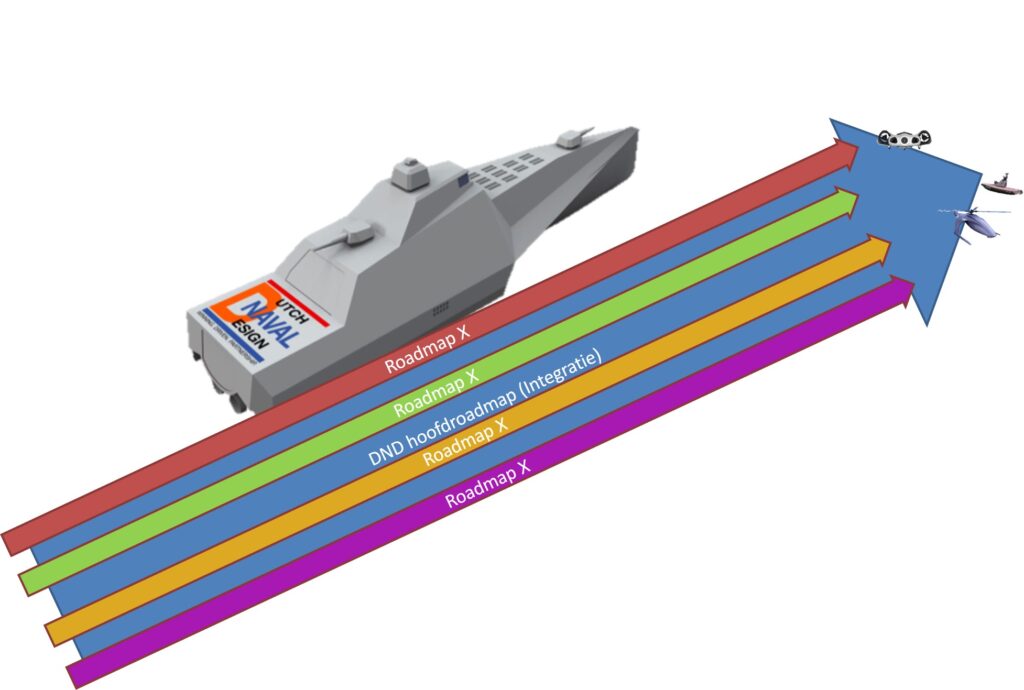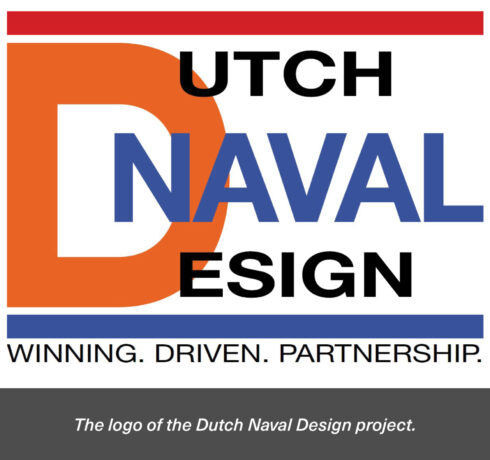How will future naval ships operate? That is the question that the Ministry of Defence, knowledge institutes and the defence industry are hoping to answer in the project Dutch Naval Design. Damen Naval played a major role in the writing of the plan of action for this project. The future Naval platform will be a FlexShip, operating in a network of manned and unmanned systems. Last year, DMO came up with a plan to introduce more focus and direction with regards to platform innovation. The idea was to define development roadmaps on several themes within the naval architecture cluster in order to arrive at a common point on the horizon.
In Dutch Naval Design, the Ministries of Defence and Economic Affairs, the knowledge institutes MARIN, TNO, TU Delft and the Netherlands Aerospace Centre, and the Netherlands Industries for Defence and Security (NIDV) are working together. In a management group within the new knowledge platform, Damen Naval, on behalf of the Dutch defence industry, has drawn up a plan of action that clarifies the reasons for Dutch Naval Design. Damen Naval – in particular Joep Broekhuijsen – contributed greatly to writing this plan.
“We describe what future operations of a Naval platform will look like,” says Joep. “The point on the horizon which we will see around the year 2050 is a so-called FlexShip, a ship that, as the name suggests, is flexible and adaptable. The name also refers to the English flagship. I think that in the future we will no longer be talking about one ship with all its functionalities. Future naval platforms will have manned and unmanned systems, and in the air, on the water and under water, a mix of remotely operated autonomous systems will be supported by one or more mother ships.”
 With Joep van Broekhuijsen at the helm, Damen Naval plays an important role in the Dutch Naval Design project.
With Joep van Broekhuijsen at the helm, Damen Naval plays an important role in the Dutch Naval Design project.
“The FlexShip itself has a high degree of automation and has a small crew, which is optimally supported by that automation,” Joep continues. “In short, the motto here is: have onboard what you need to have and place what you can on the shore. But you should also think about the possibility of small and fast unmanned vessels circling around the mother ship and looking beyond the horizon like the eyes and ears of the ship. They can support the FlexShip in its operations by, for example, creating a decoy to deflect an enemy attack.”
“The advantage of all these new unmanned systems is also that, because of their looser relationship with the mother ship, they can be quickly customised as a payload to the mission that the ship has. Also, technological upgrades are easier to implement without complex maintenance programmes. This way, the FlexShip responds to the increasingly rapid development of technology and remains operationally relevant for longer.” According to Joep, the FlexShip will also be highly camouflaged and silent, and of course it will not emit any pollutants.
"In the air, on the water and under water, a mix of remotely operated autonomous systems will be supported by one or more mother ships.” Joep Broekhuijsen
The naval platform of the future will therefore be a very different ship from the warships known today. DMO, the Defence Materiel Organisation, started the Dutch Naval Design project because it believes that the development of platform technology needs a boost. The Netherlands Radarland project, which is already underway, was taken as an example. The arrival of the new knowledge platform is a further step in the development of the Golden Triangle, which has been formed for many years by the Royal Netherlands Navy, the maritime commercial sector and knowledge institutes.
Joep: “The question we need to ask ourselves is what the most important tasks of future naval platforms will be and what requirements we will demand from such a FlexShip. What functionalities do you assign to it and how do you ensure that, with a mix of unmanned and manned tasks, cooperation between the mother ship and the autonomous systems runs smoothly? Another issue to consider is the fact that threats are becoming more complex and unpredictable and that there is a trend to want to protect crews more and more, so you keep humans away from dangerous tasks on the front line as much as possible.”
“In general, the crews on board naval ships are getting smaller and smaller. Current technology, with artificial intelligence, robotisation, computing power and sensorics, makes it possible to sail with fewer and fewer people.” According to Joep, Dutch Naval Design will certainly bear fruit. “It is best to pool subsidy money together to realise certain developments. I like to think about this in my role as manager of the Research & Development portfolio at Damen Naval. I find it interesting to be able to help determine the direction in which the Naval Architecture cluster is heading in this project.
 Of the total of seven development directions, the so-called roadmaps, included in the plan, Damen Naval is taking on the one for smart maintenance.
Of the total of seven development directions, the so-called roadmaps, included in the plan, Damen Naval is taking on the one for smart maintenance.
“The technological developments that are going on now will ultimately be a game changer for how naval platforms operate in the future. And this project comes at the right time, because there are a lot of subsidy opportunities right now, both in the Netherlands and from Brussels, for new developments in shipbuilding. Eight billion euros of European subsidy are available for defence-related research and in the years to come, Brussels will allocate 500 million euros to support public-private initiatives for the development and construction of sustainable ships.”
Dutch Naval Design is a multi-year plan. “There is no end date attached to it,” Joep explains. “The plan of action is now ready, and early next year we will be organising workshops to develop the plans further. We have to spring into action now, because this is a project that requires permanent attention to make it a success. In any case, it offers great opportunities for Damen Naval as a partner within the naval architecture cluster.” Of the total of seven development directions, the so-called roadmaps, included in the plan, Damen Naval is taking on the one for smart maintenance.
"We have to spring into action now, because this is a project that requires permanent attention to make it a success.” Joep Broekhuijsen
That is a technological roadmap, aimed at increasing the reliability and availability of the naval platform through active monitoring and the digitalisation of the supply chain. “But we are also involved, to a lesser extent, in the other six roadmaps.” The Dutch Naval Design plan of action has now been handed over to the DMO Director, Vice-Admiral Arie Jan de Waard. “But the document will soon be publicly available to everyone,” Joep concludes.
“Because, in addition to the Dutch maritime industry, we want the entire Dutch industry to have the opportunity to think along with us about a common vision for the future performance of the next generation of naval ships. That is why any Dutch company can sign up for our workshops in January, although they are primarily intended for the NIDV.”

